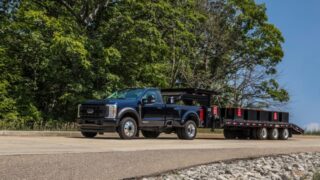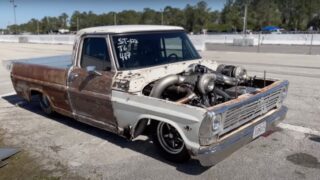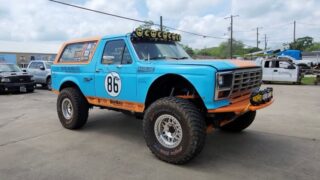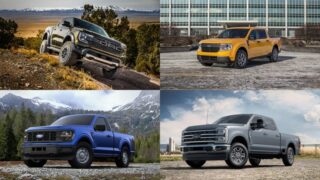Installation of Manual or Power Brakes Disc Brakes in a 1957 – 1964 F100
by Mark J. Covill
| Before | After |
 |
|
The disc brake conversion instructions are complied from various sources readily available online and parts I purchased. I took the time to bring them altogether and a few things I learned while assembling the parts. While you are reading these instructions you will find two options for actuating the disc brakes; power and manual. By adding the brake booster it will allow for easier effort. However, it may not be feasible due to a lack of enough engine vacuum to properly assist them. I chose a basic kit consisting of the brackets, bracket spacers, and hardware to attach them to my existing spindles. Try to find a kit that does not use inner bearing spacers as commonly found with some of the cheaper kits. The parts list is gathered from all the sources I found/remember. You’ll notice it is listed by year/make, vendor part #, and quantity. It may take a little research to find them if you don’t opt to buy a full kit. You’ll also notice that full kits are cheaper to buy then the list of parts below but cost more initially out of pocket. From my personal experience buying a little at a time will allow for you to take your time and not rush the installation process.
A note of caution, these instructions are a guide to install disc brakes. I don’t know your level of mechanical experience and will not be held responsible for damage, missing/lost body parts, collisions, medical expenses, broken tools, mangled parts, sleeping on the couch because she said so, lost meals, cases of beer consumed, sleepless nights, or you yelling profanities at others. You have been forewarned.
I took the time to remove, clean, inspect, and paint all the steering components that come off during the brake conversion. These steps are not required but they do make the final product look much better. I can’t stand to see 40 years of dirt on one part that attaches to a brand new clean one. This is just my personal pet peeve. While I was at it, I replaced all the rear brake components as well. No sense in having new front brakes with old brakes in the rear. You’ll also see pictures with steel braided caliper lines. These are available to accept standard hard line nuts but cost 3 times the price of stock rubber ones. I also used a new proportioning valve since I couldn’t find a good used one. The pushrod and booster hardware is available at most auto parts or home improvement stores. Just take the booster with you to ensure the hardware fits.
>
Parts from local auto parts
|
Year and Make |
Mfr and Part # |
Price |
|
57-64 F-100 |
BCA Front Inner Bearing Seal 44053 |
23.99 per, need 2 |
|
76 F100 2WD |
Raybestos Front rotors 5006RGS |
42.99 per, need 2 |
|
76 F100 2WD |
Cardone |
16.99 plus core |
|
76 F100 2WD |
Cardone Dual Master Cylinder 101617 |
14.99 plus core |
|
76 F100 2WD |
Dorman dust cap 13973 |
3.99 per, need 2 |
|
76 Chevy Camero |
BCA taper bearing A2 (Outer Rotor Bearing) |
9.59 per, need 2 |
|
76 Chevy Impala |
Cardone Calipers 184035 Right /184036 Left | 12.99 per + core, need 2 |
| 76 Chevy Impala | USA Brake Lock 14572 | 3.59 per, need 2 |
|
76 Chevy Impala |
Tru Torque brake hose H80965 |
16.96 per, need 2 |
|
76 Chevy Impala |
your choice brake pads |
call |
| 76 Chevy Impala | Dorman Banjo Bolt 4842001 |
3.29 per, need 2 |
Parts sourced from various vendors online.
|
Universal Dual Diaphragm Booster |
Found online through a common auction site |
85.00 and up plus shipping |
| Basic Kit | EC-732 | 140.00 |
| Disc/Drum Brake Proportioning Valve |
PV-2 |
49.00 and up new |
|
Power Brake Booster Brackets |
5564BBL and 5564BBR |
15.00 per, 2 needed |
Booster pushrod and mounting hardware
|
4 ½” long x 3/8-24 threaded rod |
Remember to take the booster with you to ensure all the hardware fits. I also recommend you buy washers with the mounting nuts. |
|---|---|
|
3/8-24 RH female shank rod end |
|
|
1 ½” long x 3/8-24 pushrod nut |
|
|
3/8-24 nut, 2 required |
|
|
4 booster to firewall bracket mount nuts |
|
|
2 master cylinder to booster mount nuts |
Note: Before you start, check the wheels you plan on using. The rotors are 11 ¾ inch with 5 ½ inch bolt pattern and will require a minimum of 15 inch wheels. The rotors will also move each side in ½ inch.
- As with all automotive repairs, remember safety is your first concern. Block the wheels and always use jack stands to support the weight of the truck.
-
Remove your old wheel and brake drum. Remove the brake hardware and hose. The only items needed for the installation of the disc brake kit is the stock bearing retainer nut, nut lock, and washer.
Notice the nut and washer at the end of the spindle of the second picture. The nut and washer are located under the grease cap along with the nut retaining lock and cotter key.
Once all the hardware is off, clean and inspect the spindle bearing surfaces and seal flange. Also clean and inspect the axle pivot lugs and king pin for wear. What better time to find the need to replace the spindle or king pins then now. - Check the location of the king pin retaining nut. If it is located on the rear of the spindle it needs to be flipped around to the front. The caliper will contact the king pin lock nut otherwise. A note of caution, while the king pin lock is removed DO NOT rotate the spindle. It is a bear of a time to line it up again properly if the king pin rotates.
-
Check the fitment of the caliper brackets. The brackets are installed on the trailing side of the axle on the inner (engine) side of the spindle as shown in the pictures. Also note the location of the tab welded on. You will know if you install it wrong since the brackets won’t seat flush against the back of the spindle with the steering arm installed. The brackets I received weren’t marked for what side they went on so I learned the hard way. Install the bracket with 2 of the ½ -20 x 2 ¼ inch long bolts at the top, spacers, and locknuts provided with the kit. The bracket spacers are placed between the spindle and upper bracket holes, see picture. The placement of the nuts is your option since they fit inside the rotor EXCEPT for the forward lower bolt. It must be facing outboard on the rotor side Attach the stock steering arm with the remaining bolts, ½ – 20 x 2 ¾ bolt in the lower aft hole and ½ – 20 x 2 ½ bolt in the forward lower hole. Ensure you place the correct bolts in the right holes.
-
The Impala caliper or the bracket must be modified for the caliper to slide freely back and forth.
Personally I prefer to modify the caliper since the bracket holds the rotational force while clamping.
Take the caliper for the side you are working on, bleeder up, and mount it on the caliper bracket with the hardware. Notice the caliper does not slide all the way in and out. Mark the area with a sharpie marker that makes contact. Use a grinder to grind/smooth the bump off the housing or cut a notch in the bracket to fit the caliper bump. Before grinding on the caliper make sure to cap the hose bolt hole if you removed the shipping plugs. Take your time grinding. If you slip off the edge of the casting you may damage the piston boot. Completely clean off any grinding dust from the caliper before moving on.
I took the time to remove all the casting flash from the caliper housings. -
Remount the caliper in the bracket and check for clearance issues. I had to adjust the steering arm stop to keep the caliper from coming in contact with the steering linkages at full turn. Once you are certain the caliper is installed correctly remove it.
As a side note, I purchased a high temp paint to beautify the caliper after it properly fit in the bracket. This is not a requirement just a suggestion.
-
The stock Ford truck rotor will need the bearing races removed that came with it. The new A2 outer bearing will not fit these.
A little tech note, it is always a good idea to replace the races that come on a rotor. The races are installed and used during the rotor surfacing operation. Metal shavings can get trapped behind them that will get into your new bearings and grease.
Use a suitable punch and hammer to remove them. Make sure not to damage the bore inside the rotor. Once removed install the race that came with the new bearings with a race/seal installation tool. Do not grease the bearings or install the seal yet. >
-
Install the rotor with the bearings in place using the retained original nut and washer. Do not tighten the nut down more then finger tight. Install the caliper with the brake pads and check for proper alignment.
I found after driving the brake pad made contact with the rotor hub. If this happens you can grind a little off the edges of the brake pad metal bracket for extra clearance. I highlighted the area of the pad that contacted the rotor hat in yellow.
You may also want to install the wheel with a couple of lug nuts to check for any clearance issues.
-
Remove the caliper and rotor you just installed. Grease the bearings with fresh clean grease; install the grease seal you left out in step 6. Re-mount the rotor on the spindle with the nut and washer. Torque the nut to get the proper amount of preload on the bearings. Preloading is a small amount of friction put upon the bearings to ensure they are properly seated.
I torque the spindle nut using a spring gauge to rotate the rotor to obtain 10-12 lbs for preload. You may have to play with it for a while to get the nut lock castellation to line up with the cotter key hole.
Install the castellated nut lock over the spindle nut and cotter key. Install the caliper with the brake pads and tighten the caliper bolts. Connect the brake lines with the crush washers and banjo bolt. Slide the other end of the brake hose through the frame and install the hose clip.
-
Go back and repeat steps 1-8 on the other side.
-
Now it is time to do the rest of the conversion. I used a 7″ dual diaphragm booster for valve cover clearance. To figure the diameter booster to use draw 3 rings (7″, 8″, and a 9″) on a piece of paper. Cut the excess paper outside the 9″ ring and center it on your master cylinder. You will see how much clearance you have to buy the right size booster.
Power brakes are not required if you don’t want them or don’t have enough vacuum.
-
Remove the old master cylinder, pushrod, brake arm, and firewall adapter for the manual master cylinder.
If you are not adding a power brake booster, leave the brake arm and firewall adapter alone.
To remove the brake arm will require you to be under the dash for 10-15 minutes.
If your like me stretch out a little before crawling under the dash. It will help trust me.
The brake arm has a ¾ inch rod that holds it in place. To remove the rod you will find a metal clip on the outboard of the right brake arm rod support. Slide the clip off and pull the rod from the left side. Remember there are a few plastic washers that are pinched between the arm and rod bushings that need to be reinstalled, so don’t lose them. If you also have the clutch pedal installed make sure you don’t knock yourself in the head. It may drop down a few inches.
Running an automatic transmission and want to stop the tapping sound you hear when pushing the gas pedal through the floor? Just slide the rod all the way out and remove the clutch pedal.
Once the brake arm is out you will need to modify it. The power brake booster needs another bolt hole drilled ¾’s of an inch lower then the original one. The new hole will keep the brakes from being touchy. Once the hole is drilled reinstall it in reverse order and don’t forget to lube the rod bushings, reinstall the plastic washers, and the clip.
> -
Skip this step if you are running manual brakes or have room to mount the booster lower.
The booster brackets may need a set of holes drilled in them to mount on the fire wall using the 55-64 truck brackets with a BBF motor installed. These brackets will slightly angle the master cylinder up. To modify them without having to drill huge holes in them will require some trail fittings with the booster bolted to the brackets for clearance from the valve covers.
Start by only attaching the booster/brackets with the top bolts on the firewall. This will allow you to slide the bracket up and down as needed to gain enough clearance to pull the driver side valve cover off. Once you have found the right placement on the firewall tighten the bolts down. Once the upper bolts are tight you will need to center punch the brackets from inside the cab. Crawl back under the dash and use a center punch through the lower bolt holes.
Aren’t you glad you stretched out before this?
Don’t have a center punch, no problem; simply draw the vertical and horizontal center lines of the bolt holes with a sharpie marker on the firewall. Make sure to extend the marks on the fire wall enough to see the lines with the brackets installed. Then bolt them on and use the lines to mark the center. Take them off and drill the holes slightly larger then the bolts. -
Skip this step if you are running manual brakes.
Since the manual master cylinder adapter is no longer attached to the firewall you will have a 2 ½ inch hole. I made a panel with an oval hole and rubber seal to fill in the large hole so water or exhaust fumes don’t enter the cab from there.This is your option since a piece of rubber will do the same thing with a slit cut in it.
The panel is made by clamping a piece of metal to the booster brackets after drilling a hole for the threaded rod extending out the back of the booster. I marked the edges and bolt holes with a marker. I drew the planned outline of the pushrod hole at this point but didn’t cut it out. The reason for this is the brake arm hole is lower then original. Take the metal panel off and cut/drill it to size. Now bolt everything back on the firewall with the panel between the two. Crawl back under the dash and attach the booster rod hardware. Compare the booster rod hardware and new brake arm rod bolt hole on the brake arm. Make adjustments to your outlined oval as needed. Remove the booster rod hardware and cut out the oval with a Dremal tool.
Check to make sure you have enough space around the hardware to prevent binding or a loud metal on metal screech as I had.
Once no contact exists, remove the booster/panel and sandwich the rubber against the firewall and tighten it down. Install the brake arm rod retaining clip you left off in step 10 if you haven’t already.
-
Skip this step if you are running manual brakes.
Bolt the dual master cylinder on the booster. You will need to adjust the booster rod to master cylinder piston. Don’t rush this step. If you extend the screw too far your brakes will drag and so on. Too short and there will be a delay in engaging the brakes. Adjust the pushrod hardware to get the proper pedal height. This may take a few times to get the pedal adjusted properly. You want the piton in the master cylinder to bottom out before the pedal touches the floor. Leave ¾’s to 1″ of a gap between the pedal and floor.If you do not have a carpet or floor mat in the cab take this into consideration when setting the pedal height.
-
Mount the proportioning valve any where you prefer.
I mounted mine right under the master cylinder for easier access. I made my own brake lines and bracket to do this.
You’ll notice the master to proportioning valve has several different size line nuts and a single wire connector.
Parts stores like Napa Auto carries all the different lines you could possibly think of. Try not to use adapters since these allow for more areas that can leak. In some cases you have no other choice but be mindful of that. I won’t get into building lines since there are articles that cover this in great detail.
The single wire connector is for a “brake warning” light. It lets you know when you have a fluid pressure drop between the reservoirs that can cause the brakes to fail. To make the connection work all you need to do is run a fused 12v wire to it through a light bulb or LED. When the pressure drops between the two lines it will ground which completes the circuit.
-
Route your brake lines so they are protected from road debris and moving parts.
I use wire coat hangers to figure out all the routing and bends before touching the first brake line.
Connect them to the frame with line clamps every few feet. The front calipers need to be connected to the system as well. Remember when converting from the old style single master to a newer dual master cylinder you will need a brass tee fitting to use the brake light pressure switch. You will see the one I used in the picture above step #16.
-
Remove the master and bench bleed it. Keep bench bleeding the dual master cylinder until all the air bubbles are gone. To do this the easiest use a bleed kit from the HELP section of an auto parts store. The kit will have several different size adapters to thread into the master cylinder line ports. Thread the adapters and connect the plastic tubes, then submerge and hold the tubes under the fluid level of the reservoir. Push the piston back and forth in its bore slowly. If you push too hard you might pop a plastic hose off and spray fluid all over. Reinstall the master cylinder after you have bench bled it.
If you don’t bleed the master cylinder by itself before connecting the brake lines you will be pumping forever to clear all the air out of the lines.
Connect the brake lines to the master cylinder and bleed the brakes starting on the farthest wheel from the master cylinder first. In this case passenger rear and front wheels.
-
Skip this step if you are running manual brakes.
For the vacuum line I used 2 brass fittings to make the manifold tee. One with a 90 degree to fit the booster vacuum line and the other straight. I drilled and tapped a hole on the top of the 90 degree fitting for my automatic transmission vacuum port to be threaded into. To ensure a vacuum tight seal use Permatex aircraft gasket maker on the 90 degree elbow threads.



The picture below is how not to install the brackets as I found out later. I was trial fitting








That is all there is to install disc brakes to your truck. If you took your time and read the instructions a few times to understand them you should have a full head of hair left. Unless you are like me, then you have massive hair follicle impairment (MHFI).




